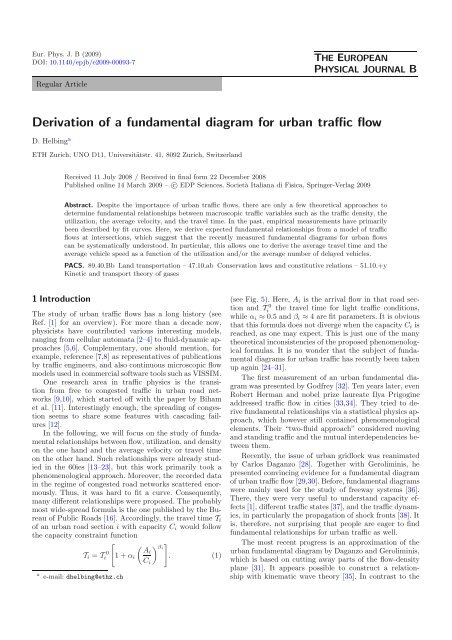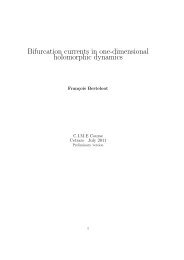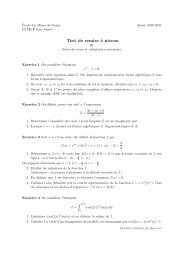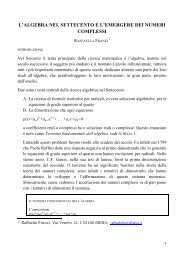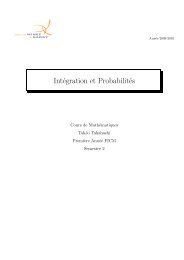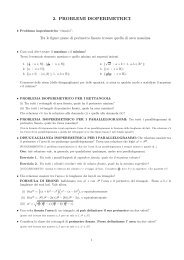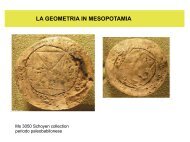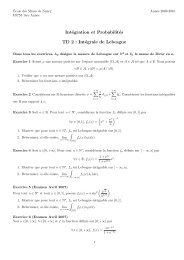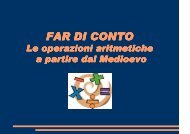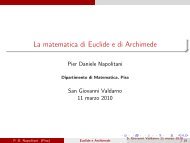Derivation of a fundamental diagram for urban traffic flow
Derivation of a fundamental diagram for urban traffic flow
Derivation of a fundamental diagram for urban traffic flow
You also want an ePaper? Increase the reach of your titles
YUMPU automatically turns print PDFs into web optimized ePapers that Google loves.
Eur. Phys. J. B (2009)<br />
DOI: 10.1140/epjb/e2009-00093-7<br />
Regular Article<br />
THE EUROPEAN<br />
PHYSICAL JOURNAL B<br />
<strong>Derivation</strong> <strong>of</strong> a <strong>fundamental</strong> <strong>diagram</strong> <strong>for</strong> <strong>urban</strong> <strong>traffic</strong> <strong>flow</strong><br />
D. Helbing a<br />
ETH Zurich, UNO D11, Universitätstr. 41, 8092 Zurich, Switzerland<br />
Received 11 July 2008 / Received in final <strong>for</strong>m 22 December 2008<br />
Published online 14 March 2009 – c○ EDP Sciences, Società Italiana di Fisica, Springer-Verlag 2009<br />
Abstract. Despite the importance <strong>of</strong> <strong>urban</strong> <strong>traffic</strong> <strong>flow</strong>s, there are only a few theoretical approaches to<br />
determine <strong>fundamental</strong> relationships between macroscopic <strong>traffic</strong> variables such as the <strong>traffic</strong> density, the<br />
utilization, the average velocity, and the travel time. In the past, empirical measurements have primarily<br />
been described by fit curves. Here, we derive expected <strong>fundamental</strong> relationships from a model <strong>of</strong> <strong>traffic</strong><br />
<strong>flow</strong>s at intersections, which suggest that the recently measured <strong>fundamental</strong> <strong>diagram</strong>s <strong>for</strong> <strong>urban</strong> <strong>flow</strong>s<br />
can be systematically understood. In particular, this allows one to derive the average travel time and the<br />
average vehicle speed as a function <strong>of</strong> the utilization and/or the average number <strong>of</strong> delayed vehicles.<br />
PACS. 89.40.Bb Land transportation – 47.10.ab Conservation laws and constitutive relations – 51.10.+y<br />
Kinetic and transport theory <strong>of</strong> gases<br />
1 Introduction<br />
The study <strong>of</strong> <strong>urban</strong> <strong>traffic</strong> <strong>flow</strong>s has a long history (see<br />
Ref. [1] <strong>for</strong> an overview). For more than a decade now,<br />
physicists have contributed various interesting models,<br />
ranging from cellular automata [2–4] to fluid-dynamic approaches<br />
[5,6]. Complementary, one should mention, <strong>for</strong><br />
example, reference [7,8] as representatives <strong>of</strong> publications<br />
by <strong>traffic</strong> engineers, and also continuous microscopic <strong>flow</strong><br />
models used in commercial s<strong>of</strong>tware tools such as VISSIM.<br />
One research area in <strong>traffic</strong> physics is the transition<br />
from free to congested <strong>traffic</strong> in <strong>urban</strong> road networks<br />
[9,10], which started <strong>of</strong>f with the paper by Biham<br />
et al. [11]. Interestingly enough, the spreading <strong>of</strong> congestion<br />
seems to share some features with cascading failures<br />
[12].<br />
In the following, we will focus on the study <strong>of</strong> <strong>fundamental</strong><br />
relationships between <strong>flow</strong>, utilization, and density<br />
on the one hand and the average velocity or travel time<br />
on the other hand. Such relationships were already studied<br />
in the 60ies [13–23], but this work primarily took a<br />
phenomenological approach. Moreover, the recorded data<br />
in the regime <strong>of</strong> congested road networks scattered enormously.<br />
Thus, it was hard to fit a curve. Consequently,<br />
many different relationships were proposed. The probably<br />
most wide-spread <strong>for</strong>mula is the one published by the Bureau<br />
<strong>of</strong> Public Roads [16]. Accordingly, the travel time T i<br />
<strong>of</strong> an <strong>urban</strong> road section i with capacity C i would follow<br />
the capacity constraint function<br />
a<br />
T i = T 0<br />
i<br />
[<br />
e-mail: dhelbing@ethz.ch<br />
1+α i<br />
(<br />
Ai<br />
C i<br />
) βi<br />
]<br />
. (1)<br />
(see Fig. 5). Here, A i is the arrival <strong>flow</strong> in that road section<br />
and Ti<br />
0 the travel time <strong>for</strong> light <strong>traffic</strong> conditions,<br />
while α i ≈ 0.5 andβ i ≈ 4 are fit parameters. It is obvious<br />
that this <strong>for</strong>mula does not diverge when the capacity C i is<br />
reached, as one may expect. This is just one <strong>of</strong> the many<br />
theoretical inconsistencies <strong>of</strong> the proposed phenomenological<br />
<strong>for</strong>mulas. It is no wonder that the subject <strong>of</strong> <strong>fundamental</strong><br />
<strong>diagram</strong>s <strong>for</strong> <strong>urban</strong> <strong>traffic</strong> has recently been taken<br />
up again [24–31].<br />
The first measurement <strong>of</strong> an <strong>urban</strong> <strong>fundamental</strong> <strong>diagram</strong><br />
was presented by Godfrey [32]. Ten years later, even<br />
Robert Herman and nobel prize laureate Ilya Prigogine<br />
addressed <strong>traffic</strong> <strong>flow</strong> in cities [33,34]. They tried to derive<br />
<strong>fundamental</strong> relationships via a statistical physics approach,<br />
which however still contained phenomenological<br />
elements. Their “two-fluid approach” considered moving<br />
and standing <strong>traffic</strong> and the mutual interdependencies between<br />
them.<br />
Recently, the issue <strong>of</strong> <strong>urban</strong> gridlock was reanimated<br />
by Carlos Daganzo [28]. Together with Geroliminis, he<br />
presented convincing evidence <strong>for</strong> a <strong>fundamental</strong> <strong>diagram</strong><br />
<strong>of</strong> <strong>urban</strong> <strong>traffic</strong> <strong>flow</strong> [29,30]. Be<strong>for</strong>e, <strong>fundamental</strong> <strong>diagram</strong>s<br />
were mainly used <strong>for</strong> the study <strong>of</strong> freeway systems [36].<br />
There, they were very useful to understand capacity effects<br />
[1], different <strong>traffic</strong> states [37], and the <strong>traffic</strong> dynamics,<br />
in particularly the propagation <strong>of</strong> shock fronts [38]. It<br />
is, there<strong>for</strong>e, not surprising that people are eager to find<br />
<strong>fundamental</strong> relationships <strong>for</strong> <strong>urban</strong> <strong>traffic</strong> as well.<br />
The most recent progress is an approximation <strong>of</strong> the<br />
<strong>urban</strong> <strong>fundamental</strong> <strong>diagram</strong> by Daganzo and Geroliminis,<br />
which is based on cutting away parts <strong>of</strong> the <strong>flow</strong>-density<br />
plane [31]. It appears possible to construct a relationship<br />
with kinematic wave theory [35]. In contrast to the
2 The European Physical Journal B<br />
density-based approach by Daganzo et al., we will pursue<br />
an alternative, utilization-based approach. This is common<br />
in queueing theory [39] and transportation planning,<br />
where <strong>for</strong>mulas such as the capacity constraint function<br />
(1) areused.<br />
After discussing elementary relationships <strong>for</strong> cyclically<br />
signalized intersections <strong>of</strong> <strong>urban</strong> road networks in Section<br />
2, we will start in Section 3 with the discussion <strong>of</strong><br />
undersaturated <strong>traffic</strong> conditions and derive a relationship<br />
<strong>for</strong> the average travel time as a function <strong>of</strong> the utilization<br />
or the number <strong>of</strong> delayed vehicles. Furthermore, we will<br />
determine a <strong>for</strong>mula <strong>for</strong> the average speed. In Section 4,<br />
we will extend the analysis to congested road conditions,<br />
where the intersection capacity is exceeded. Afterwards,<br />
in Section 5, we will indicate how to deal with oversaturated<br />
networks, where the link capacity is insufficient to<br />
take up all vehicles that would like to enter a road section.<br />
Finally, Section 6 provides a summary and discussion.<br />
In particularly, we will address issues regarding the<br />
transfer <strong>of</strong> link-based <strong>fundamental</strong> <strong>diagram</strong>s to <strong>urban</strong> areas.<br />
We also try to connect the density-based <strong>fundamental</strong><br />
<strong>diagram</strong> <strong>of</strong> Daganzo et al. with the utilization-based approach<br />
developed here.<br />
2 Elementary relationships <strong>for</strong> cyclically<br />
operated intersections<br />
Let us study a single intersection with a periodically operated<br />
<strong>traffic</strong> light. We shall have green phases j <strong>of</strong> duration<br />
ΔT j , during which one or several <strong>of</strong> the <strong>traffic</strong> streams i<br />
are served. β ij shallbe1,if<strong>traffic</strong>streami is served by<br />
green phase j, otherwiseβ ij =0.Thesetuptimeafter<br />
phase j shall require a time period τ j . It may be imagined<br />
to correspond to the time period <strong>of</strong> the amber light (although<br />
in practice, this has to be corrected <strong>for</strong> reaction<br />
times and intersection clearing times). The sum <strong>of</strong> setup<br />
times will be called the “lost service time”<br />
T los = ∑ j<br />
τ j , (2)<br />
while the sum <strong>of</strong> all green time periods and setup times<br />
will be called the “cycle time”<br />
T cyc = ∑ j<br />
(ΔT j + τ j )=T los + ∑ j<br />
ΔT j . (3)<br />
The green times are also sometimes expressed as fractions<br />
f j ≥ 0 <strong>of</strong> the cycle time, i.e.<br />
ΔT j = f j T cyc (4)<br />
with ∑ j f j < 1. After inserting this into equation (3) and<br />
rearranging terms, we get<br />
T los<br />
T cyc ({f j })=<br />
1 − ∑ j f , (5)<br />
j<br />
i.e. the cycle time is proportional to the lost service time<br />
T los .<br />
Assuming average in<strong>flow</strong>s A i per lane, the number <strong>of</strong><br />
vehicles belonging to <strong>traffic</strong> stream i, which must be served<br />
within one cycle time T cyc , amounts to A i T cyc .Inorder<br />
to avoid the <strong>for</strong>mation <strong>of</strong> growing queues (i.e. the onset <strong>of</strong><br />
congestion), the number <strong>of</strong> served vehicles per cycle time<br />
and lane must reach this value. The number <strong>of</strong> vehicles <strong>of</strong><br />
<strong>traffic</strong> stream i potentially served during the green phases<br />
ΔT j is given by ∑ j Q ijβ ij ΔT j per lane, where Q ij denotes<br />
the out<strong>flow</strong> capacity (discharge <strong>flow</strong>) per lane, when<br />
stream i is served by phase j. If we want to have a certain<br />
amount <strong>of</strong> excess capacity to cope with a variability <strong>of</strong> the<br />
in<strong>flow</strong>s, we may demand<br />
(1 + δ i )A i T cyc = ∑ j<br />
Q ij β ij ΔT j = ∑ j<br />
Q ij β ij f j T cyc (6)<br />
with δ i > 0. This linear set <strong>of</strong> equations may be solved<br />
<strong>for</strong> the green time fractions f j . In the following, we will<br />
assume the case, where not several <strong>traffic</strong> streams i are<br />
served in parallel by one and the same green phase, but<br />
where each phase j serves a single <strong>traffic</strong> stream i. Then,<br />
we may assume β ij =1,ifj = i, andβ ij =0otherwise.<br />
Furthermore, Q ij = Q ii = ̂Q i . With this, equation (6)<br />
implies<br />
f i (u i ,δ i )=(1+δ i ) A i<br />
̂Q i<br />
=(1+δ i )u i , (7)<br />
where<br />
u i = A i<br />
(8)<br />
̂Q i<br />
is called the utilization <strong>of</strong> the service or out<strong>flow</strong> capacity<br />
̂Q i (see Fig. 1). δ i ≥ 0 is a safety factor to cope with<br />
variations in the arrival <strong>flow</strong> (in<strong>flow</strong>) A i . According to<br />
equation (5) wemusthave<br />
0 < 1 − ∑ i<br />
f i =1− ∑ i<br />
(1 + δ i ) A i<br />
̂Q i<br />
. (9)<br />
Otherwise, we will have growing vehicle queues from one<br />
signal cycle to the next, corresponding to the congested<br />
<strong>traffic</strong> regime.<br />
Note that, at time t, thenumberN i (t) <strong>of</strong> vehicles per<br />
lane in the road section reserved <strong>for</strong> <strong>traffic</strong> stream i is<br />
given by the time integral <strong>of</strong> the arrival <strong>flow</strong> A i (t) minus<br />
the departure <strong>flow</strong> γ i (t)O i (t):<br />
∫ t<br />
N i (t) = dt ′[ ]<br />
A i (t ′ ) − γ i (t ′ )O i (t ′ ) . (10)<br />
t 0<br />
Here, the starting time t 0 must be properly chosen to give<br />
the correct initial number <strong>of</strong> vehicles on road section i.<br />
During the amber and red time periods, we set the permeability<br />
γ i (t) = 0, as there is no out<strong>flow</strong>, while γ i (t) =1<br />
during green phases. The departure <strong>flow</strong> O i per lane is<br />
given by the service capacity ̂Q i per lane, as long as there
D. Helbing: <strong>Derivation</strong> <strong>of</strong> a <strong>fundamental</strong> <strong>diagram</strong> <strong>for</strong> <strong>urban</strong> <strong>traffic</strong> <strong>flow</strong> 3<br />
integral <strong>of</strong> the arrival <strong>flow</strong> A i (t −Ti 0 ) expected at the end<br />
<strong>of</strong> road section i under free <strong>flow</strong> conditions. Altogether,<br />
the number <strong>of</strong> delayed vehicles can be calculated as<br />
Fig. 1. Schematic illustration <strong>of</strong> vehicle trajectories <strong>for</strong> a <strong>traffic</strong><br />
light, which has an amber and red time period <strong>of</strong> altogether<br />
(1 − f i)T cyc and a green time period <strong>of</strong> f iT cyc. Vehicles move<br />
<strong>for</strong>ward at the free speed Vi<br />
0 or are stopped in a vehicle queue<br />
(horizontal lines), which <strong>for</strong>ms during the amber and red time<br />
period behind the <strong>traffic</strong> light (located at the t-axis). The speed<br />
<strong>of</strong> the upstream moving congestion front is given by the arrival<br />
<strong>flow</strong> [38] and denoted by c i ≤ 0. The dissolution speed<br />
c 0 < 0 <strong>of</strong> congested <strong>traffic</strong> is a characteristic constant with<br />
|c 0|≥|c i| [6,40]. The average delay time can be determined by<br />
averaging over the waiting times in the triangular areas. Note<br />
that <strong>for</strong> the case <strong>of</strong> an excess greentime (f i >u i), vehicles may<br />
pass the <strong>traffic</strong> light without any delay.<br />
is a positive number ΔN i (t) > 0 <strong>of</strong> delayed vehicles. If<br />
Q out represents the characteristic out<strong>flow</strong> from congested<br />
<strong>traffic</strong> per lane into an area <strong>of</strong> free <strong>flow</strong>, the overall service<br />
capacity by all service lanes is given by the minimum <strong>of</strong><br />
the number <strong>of</strong> lanes I i used by vehicle stream i upstream<br />
the intersection, and the number I i ′ <strong>of</strong> lanes downstream<br />
<strong>of</strong> it:<br />
( )<br />
I i ̂Qi =min(I i ,I i ′ )Q out, i.e. ̂Qi =min 1, I′ i<br />
Q out .<br />
I i<br />
(11)<br />
When the vehicle queue <strong>for</strong>ming behind a <strong>traffic</strong> light has<br />
completely resolved, the out<strong>flow</strong> from the road section<br />
used by vehicle stream i drops from ̂Q i to a lower value.<br />
Then, if the greentime period continues, the out<strong>flow</strong> O i (t)<br />
per lane corresponds to the arrival <strong>flow</strong> A i (t−Ti 0)perlane<br />
expected at the end <strong>of</strong> road section i under free <strong>flow</strong> conditions<br />
[40]. Here, Ti 0 = L i /Vi<br />
0 represents the travel time<br />
under free <strong>flow</strong> conditions, which is obtained by division <strong>of</strong><br />
the length L i <strong>of</strong> the road section reserved <strong>for</strong> stream i by<br />
the free speed Vi 0 . Considering also the above definition<br />
<strong>of</strong> the permeabilities γ i (t) reflecting the time-dependent<br />
states <strong>of</strong> the <strong>traffic</strong> signal, we have<br />
{ ̂Qi if ΔN<br />
γ i (t)O i (t) =γ i (t)<br />
i (t) > 0,<br />
A i (t −Ti 0)otherwise.<br />
(12)<br />
The number ΔN i (t) <strong>of</strong>delayed vehicles per lane at time<br />
t on the road section reserved <strong>for</strong> vehicle stream i can be<br />
easily determined as well. In contrast to equation (10), we<br />
have to subtract the integral <strong>of</strong> the departure <strong>flow</strong> from the<br />
ΔN i (t) =<br />
∫ t<br />
dt ′[ ]<br />
A i (t ′ −Ti 0 ) − γ i(t ′ )O i (t ′ ) . (13)<br />
t 0<br />
If the <strong>traffic</strong> <strong>flow</strong> is organized as a vehicle platoon and the<br />
green phase is synchronized with its arrival at the <strong>traffic</strong><br />
light, the number <strong>of</strong> delayed vehicles is zero. However, if<br />
the <strong>traffic</strong> <strong>flow</strong> A i is uni<strong>for</strong>m, we find<br />
∫ t<br />
ΔN i (t) =A i · (t − t 0 ) −<br />
t 0<br />
dt ′ γ i (t ′ )O i (t ′ ). (14)<br />
Let us assume that t 0 denotes the time when the green<br />
phase <strong>for</strong> <strong>traffic</strong> stream i ended. Then, the next green<br />
phase <strong>for</strong> this <strong>traffic</strong> stream starts at time t ′ 0 = t 0 +(1−<br />
f i )T cyc ,asf i T cyc is the green time period and (1 − f i )T cyc<br />
amounts to the sum <strong>of</strong> the amber and red time periods.<br />
Due to O i (t) ≥ A i (t) andO i (t ′ 0) >A i (t ′ 0), t ′ 0 − t 0 =(1−<br />
f i )T cyc is also the time period after which the maximum<br />
number ΔNi<br />
max <strong>of</strong> delayed vehicles is reached.<br />
In case <strong>of</strong> a uni<strong>for</strong>m arrival <strong>of</strong> vehicles at the rate A i =<br />
u i ̂Qi per lane we have<br />
ΔNi max (u i , {f j })=A i (1 − f i )T cyc (f i )<br />
= u i ̂Qi (1 − f i )T cyc ({f j }) . (15)<br />
Since ̂Q i −A i is the rate at which this vehicle queue can be<br />
reduced (considering the further uni<strong>for</strong>m arrival <strong>of</strong> vehicles<br />
at rate A i ), it takes a green time period <strong>of</strong><br />
T i (u i , {f j })= A i(1 − f i )T cyc<br />
= u i(1 − f i )<br />
T cyc ({f j }),<br />
̂Q i − A i<br />
1 − u i<br />
(16)<br />
until this vehicle queue is again fully resolved, and newly<br />
arriving vehicles can pass the <strong>traffic</strong> light without any delay.<br />
Finally, let us determine the average delay time <strong>of</strong> vehicles.<br />
If we have a platoon <strong>of</strong> vehicles which is served by<br />
a properly synchronized <strong>traffic</strong> light, the average delay is<br />
Ti<br />
av = Ti<br />
min = 0. However, if we have a constant arrival<br />
<strong>flow</strong> A i , the average delay T av <strong>of</strong> queued vehicles is given<br />
i<br />
by the arithmetic mean (Ti<br />
max +Ti<br />
min )/2 <strong>of</strong>themaximum<br />
delay <strong>for</strong> the first vehicle in the queue behind the <strong>traffic</strong><br />
light, which corresponds to the amber plus red time period<br />
T max<br />
i ({f j })=(1− f i )T cyc ({f j }), (17)<br />
and the minimum delay Ti<br />
min = 0 <strong>of</strong> a vehicle arriving just<br />
at the time when the queue is fully dissolved. To get the<br />
average delay, we have to weight this by the percentage<br />
<strong>of</strong> delayed vehicles. While the number <strong>of</strong> vehicles arriving<br />
during the cycle time T cyc is A i T cyc ,thenumber<strong>of</strong><br />
undelayed vehicles is given by A i (ΔT i − T i ). Considering<br />
<strong>for</strong>mulas (4) and(16), the excess green time is<br />
ΔT i − T i = f i T cyc − u i(1 − f i )T cyc<br />
1 − u i<br />
= f i − u i<br />
1 − u i<br />
T cyc . (18)
4 The European Physical Journal B<br />
(1 − f i )/(1 − u i ) ≤ 1 <strong>of</strong> vehicles is delayed, together with<br />
equations (15) and(20) we find<br />
Fig. 2. Schematic illustration <strong>of</strong> vehicle trajectories and signal<br />
operation in the case f i = u i, where there are no excess green<br />
times so that the <strong>traffic</strong> light is turned red as soon as the vehicle<br />
queue has been fully resolved.<br />
Hence, the percentage <strong>of</strong> delayed vehicles is<br />
A i [T cyc − (ΔT i − T i )]<br />
A i T cyc<br />
=1− f i − u i<br />
1 − u i<br />
= 1 − f i<br />
1 − u i<br />
≤ 1. (19)<br />
Altogether, the average delay <strong>of</strong> all vehicles is expected<br />
to be<br />
T av<br />
i (u i , {f j })= (1 − f i)<br />
(1 − u i )<br />
Inserting equation (5) gives<br />
T max<br />
i ({f j })<br />
2<br />
= (1 − f i) 2 T cyc ({f j })<br />
. (20)<br />
1 − u i 2<br />
Ti av (u i , {f j })= (1 − f i) 2 T los<br />
(1 − u i ) 2(1 − ∑ j f j) , (21)<br />
while with equation (15) weobtain<br />
Ti<br />
av (u i , {f j })= 1 − f i ΔNi max (u i , {f j })<br />
. (22)<br />
1 − u i 2u i ̂Q i<br />
There<strong>for</strong>e, the average delay time is proportional to the<br />
maximum queue length ΔNi<br />
max , but the prefactor depends<br />
on f i = (1 + δ i )u i (or the safety factor δ i , respectively).<br />
In case <strong>of</strong> no excess green time (δ i =0and<br />
f i = u i ), we just have<br />
Ti av ({u j })=(1− u i ) T cyc({u j })<br />
=<br />
2<br />
=<br />
ΔN<br />
max<br />
i ({u j })<br />
2A i<br />
ΔN<br />
max<br />
i ({u j })<br />
2u i ̂Qi<br />
(23)<br />
(see Fig. 2).<br />
Similarly to the average travel time, we may determine<br />
the average queue length. As the average number<br />
<strong>of</strong> delayed vehicles is (ΔNi<br />
max +0)/2 andafraction<br />
ΔN av<br />
i (u i , {f j })= (1 − f i)<br />
(1 − u i )<br />
ΔN max<br />
i (u i , {f j })<br />
2<br />
(1 − f i ) 2 T cyc ({f j })<br />
= u i ̂Qi<br />
(1 − u i ) 2<br />
= u i ̂Qi Ti av (u i , {f j }). (24)<br />
This remarkably simple relationship is known in queuing<br />
theory as Little’s Law [39], which holds <strong>for</strong> time-averaged<br />
variables even in the case <strong>of</strong> non-uni<strong>for</strong>m arrivals, if the<br />
system behaves stable (i.e. the queue length is not systematically<br />
growing or shrinking). It also allows one to establish<br />
a direct relationship between the “average vehicle<br />
density”<br />
ρ av<br />
av<br />
ΔNi<br />
i = (25)<br />
L i<br />
on the road section used by stream i and the utilization<br />
u i = A i / ̂Q i ,namely<br />
ρ av<br />
i = u i ̂Q i Ti<br />
av<br />
. (26)<br />
L i<br />
Note that the average density ρ av<br />
i has the same dependencies<br />
on other variables as ΔNi<br />
av or Ti<br />
av , and an additional<br />
dependency on L i , i.e. the more natural quantity to use is<br />
the queue length ΔNi av .<br />
2.1 Efficiency <strong>of</strong> <strong>traffic</strong> operation<br />
In reality, the average delay time will depend on the timedependence<br />
<strong>of</strong> the in<strong>flow</strong> A i (t),andonhowwellthe<strong>traffic</strong><br />
light is coordinated with the arrival <strong>of</strong> vehicle platoons. In<br />
particular, this implies a dependence on the signal <strong>of</strong>fsets.<br />
In the best case, the average delay is zero, but in the worst<br />
case, it may also be larger than<br />
1 − u i<br />
T cyc ({u j })= (1 − u i)T los<br />
2<br />
2(1 − ∑ j u j) , (27)<br />
see equation (20) withf i = u i . We may, there<strong>for</strong>e, introduce<br />
an efficiency coefficient ɛ i by the definition<br />
Ti<br />
av ({u j },ɛ i )=(1− ɛ i ) (1 − u i)T los<br />
2(1 − ∑ j u j)<br />
or, considering equation (24), equivalently by<br />
(28)<br />
ΔNi<br />
av<br />
(1 − u i )T los<br />
({u j },ɛ i )=(1− ɛ i )u i ̂Qi<br />
2(1 − ∑ j u j) . (29)<br />
For ɛ i = 1, the <strong>traffic</strong> light is perfectly synchronized with<br />
platoons in <strong>traffic</strong> stream i, i.e. vehicles are served without<br />
any delay, while <strong>for</strong> ɛ i = 0, the delay corresponds to<br />
uni<strong>for</strong>m arrivals <strong>of</strong> vehicles, when no excess green time<br />
is given. If the <strong>traffic</strong> light is not well synchronized with<br />
the arrival <strong>of</strong> vehicle platoons, we may even have ɛ i < 0.
D. Helbing: <strong>Derivation</strong> <strong>of</strong> a <strong>fundamental</strong> <strong>diagram</strong> <strong>for</strong> <strong>urban</strong> <strong>traffic</strong> <strong>flow</strong> 5<br />
It also makes sense to define an efficiencies not only <strong>for</strong> the<br />
<strong>traffic</strong> phases, but also <strong>for</strong> the operation <strong>of</strong> a <strong>traffic</strong> light<br />
(i.e. the full cycle). This can be done by averaging over<br />
all efficiencies ɛ i (and potentially weighting them by the<br />
number u i ̂Qi T cyc <strong>of</strong> vehicles arriving in one cycle. There<strong>for</strong>e,<br />
it makes sense to define the intersection efficiency as<br />
ɛ =<br />
∑<br />
i ɛ iu i ̂Qi<br />
∑i u i ̂Q i<br />
. (30)<br />
Note that, particularly in cases <strong>of</strong> pulsed rather than uni<strong>for</strong>m<br />
arrivals <strong>of</strong> vehicles, the efficiencies ɛ i depend on the<br />
cycle time T cyc and, there<strong>for</strong>e, also on the utilizations u i .<br />
Increasing the efficiency ɛ i <strong>for</strong> one <strong>traffic</strong> stream i will <strong>of</strong>ten<br />
(but not generally) reduce the efficiency ɛ j <strong>of</strong> another<br />
<strong>traffic</strong> stream j, which poses a great challenge to <strong>traffic</strong><br />
optimization.<br />
The exact value <strong>of</strong> the efficiency ɛ i depends on many<br />
details such as the time-dependence <strong>of</strong> the arrival <strong>flow</strong><br />
A i (t) and its average value A i , the length L i <strong>of</strong> the road<br />
section, and the signal control scheme (fixed cycle time<br />
or not, adaptive green phases or not, signal <strong>of</strong>fsets, etc.).<br />
These data and the exact signal settings are <strong>of</strong>ten not fully<br />
available and, there<strong>for</strong>e, it is reasonable to consider ɛ i as<br />
fit parameters rather than deriving complicated <strong>for</strong>mulas<br />
<strong>for</strong> them. Nevertheless, we will demonstrate the general<br />
dependence on the utilization u i in the following.<br />
For this, we will study the case <strong>of</strong> excess green times<br />
(δ i > 0), which are usually chosen to cope with the<br />
stochasticity <strong>of</strong> vehicle arrivals, i.e. the fact that the number<br />
<strong>of</strong> vehicles arriving during one cycle time is usually<br />
fluctuating. The choice δ i > 0, i.e. f i >u i , also implies<br />
A i T cyc<br />
T cyc<br />
= u i ̂Qi 0maybe<br />
derived from equations (21) and(28). We obtain<br />
1 − ɛ i = (1 − f i) 2<br />
(1 − u i ) 2 (1 − ∑ j u j)<br />
(1 − ∑ j f j) , (32)<br />
where f i (u i ,δ i )=(1+δ i )u i according to equation (7).<br />
The efficiency ɛ i is usually smaller than in the case, where<br />
the <strong>traffic</strong> light is turned red as soon as a vehicle queue<br />
has been dissolved (<strong>for</strong> exceptions see Ref. [41]). Then,<br />
ɛ i < 0<strong>for</strong>δ i > 0. Formula (32) also allows one to treat the<br />
case where the green time fractions f i and the cycle time<br />
T cyc are not adapted to the respective <strong>traffic</strong> situation,<br />
but where a fixed cycle time T cyc = Tcyc 0 andfixedgreen<br />
time fractions fi<br />
0 are implemented. This corresponds to<br />
constant green times<br />
fi 0 Tcyc({f 0 j 0 }) =<br />
f i 0T los<br />
1 − ∑ j f j<br />
0 . (33)<br />
In case <strong>of</strong> uni<strong>for</strong>m vehicle arrivals, we just have to insert<br />
the corresponding value f i = f 0 i into equation (32) to<br />
obtain ɛ i . In the case <strong>of</strong> non-uni<strong>for</strong>m arrivals, ɛ i can be<br />
understood as fit parameter <strong>of</strong> our model, which allows us<br />
to adjust our <strong>for</strong>mulas to empirical data and to quantify<br />
the efficiency <strong>of</strong> <strong>traffic</strong> light operation. In this way, we<br />
can also absorb effects <strong>of</strong> stochastic vehicle arrivals into<br />
the efficiency coefficients ɛ i , which simplifies our treatment<br />
alot.<br />
3 Fundamental relationships<br />
<strong>for</strong> undersaturated <strong>traffic</strong><br />
The travel time is generally given by the sum <strong>of</strong> the free<br />
travel time Ti 0 = L i /Vi<br />
0 and the average delay time Ti av ,<br />
where L i denotes the length <strong>of</strong> the road section used by<br />
vehicle stream i and Vi<br />
0 the free speed (or speed limit).<br />
With equation (24), we get<br />
T i ({u j },ɛ i )=T 0<br />
i<br />
+ T av<br />
i<br />
({u j },ɛ i )= L av<br />
i ΔNi ({u j },ɛ i )<br />
Vi<br />
0 + .<br />
u i ̂Qi<br />
(34)<br />
Inserting equation (29), we can express the travel time<br />
solely in terms <strong>of</strong> the utilization u i , and we have<br />
T i ({u j },ɛ i )= L i<br />
Vi<br />
0 +(1− ɛ i ) (1 − u i)T los<br />
2(1 − ∑ j u j) . (35)<br />
The <strong>for</strong>mula (35) constitutes a <strong>fundamental</strong> relationship<br />
between the average travel time Ti<br />
av on the capacity utilization<br />
u i under the assumptions made (mainly cyclical<br />
operation with certain efficiencies ɛ i ). Of course, one still<br />
needs to specify the factor (1 − ɛ i ). In case <strong>of</strong> constant arrival<br />
rates A i ,thisfactorisgivenbyequation(32), which<br />
finally results in<br />
T i (u i , {f j })= L i<br />
Vi<br />
0 + (1 − f i) 2<br />
(1 − u i )<br />
After insertion <strong>of</strong> equation (7), we get<br />
T i ({u j }, {δ j })= L i<br />
V 0<br />
i<br />
T los<br />
2(1 − ∑ j f j) . (36)<br />
[1 − (1 + δ i )u i ] 2 T los<br />
+<br />
(1 − u i )2[1 − ∑ j (1 + δ j)u j ] . (37)<br />
Sometimes, it is desireable to express the <strong>fundamental</strong> relationships<br />
in terms <strong>of</strong> the density rather than the utility.<br />
Inserting equation (35) intoTi<br />
av (u i ,ɛ i )=T i (u i ,ɛ i ) −<br />
L i /Vi 0 , and this into equation (26), we obtain the equation<br />
ρ av<br />
i<br />
({u j },ɛ i ,L i )= u i ̂Q i<br />
(1 − ɛ i ) (1 − u i)T los<br />
L i 2(1 − ∑ j u j) , (38)<br />
which can be numerically inverted to give the utilization u i<br />
as a function <strong>of</strong> the scaled densities ρ av<br />
j L j/(1−ɛ j ). The calculations<br />
are simpler in case <strong>of</strong> a fixed cycle time Tcyc 0 and<br />
an uni<strong>for</strong>m arrival <strong>of</strong> vehicles. By inserting equation (20)
6 The European Physical Journal B<br />
into (26) [andwithf i = f 0 i , T cyc = T 0 cyc ,seeEq.(33)],<br />
we get<br />
L i ρ av<br />
i (u i , {fj 0 av<br />
})=ΔNi (u i , {fj 0 })<br />
(1 − fi 0 = u i ̂Qi )2 Tcyc 0 ({f j 0})<br />
, (39)<br />
2(1 − u i )<br />
which finally yields<br />
u i (ρ av<br />
i L i , {f 0 j }) =<br />
(<br />
̂Q 1+(1− fi 0 ) 2 i Tcyc 0 ({f j 0})<br />
) −1<br />
2ρ av .<br />
i L i<br />
(40)<br />
Thiscanbeinsertedintoequation(26) togive<br />
Ti<br />
av (ρ av<br />
i L i , {fj 0 }) =<br />
u i (ρ av<br />
i<br />
ρ av<br />
i L i<br />
L i , {fj 0}) ̂Q i<br />
3.1 Transition to congested <strong>traffic</strong><br />
= ρav i L i<br />
+(1− f 0 T cyc({f 0<br />
i<br />
̂Q )2 j 0})<br />
. (41)<br />
i<br />
2<br />
The utilizations u i increase proportionally to the arrival<br />
<strong>flow</strong>s A i , i.e. they go up during the rush hour. Eventually,<br />
∑<br />
f j = ∑ (1 + δ j )u j → 1, (42)<br />
j<br />
j<br />
which means that the intersection capacity is reached.<br />
Sooner or later, there will be no excess capacities anymore,<br />
which implies δ i → 0andf i → u i .Inthiscase,<br />
we do not have any finite time periods ΔT i − T i , during<br />
which there are no delayed vehicles and where the departure<br />
<strong>flow</strong> O i (t) agrees with the arrival <strong>flow</strong> A i . There<strong>for</strong>e,<br />
O i (t) =γ i (t) ̂Q i according to equation (12), and certain relationships<br />
simplify. For example, the utilization is given<br />
as integral <strong>of</strong> the permeability over one cycle time T cyc ,<br />
divided by the cycle time itself:<br />
u i = 1<br />
T cyc<br />
t i0+T<br />
∫ cyc<br />
t i0<br />
dt ′ γ i (t ′ ). (43)<br />
Moreover, in the case <strong>of</strong> constant in- and out<strong>flow</strong>s, i.e. linear<br />
increase and decrease <strong>of</strong> the queue length, the average<br />
number ΔNi<br />
av <strong>of</strong> delayed vehicles is just given by half <strong>of</strong><br />
the maximum number <strong>of</strong> delayed vehicles 1<br />
ΔN av<br />
i<br />
=<br />
max<br />
ΔNi<br />
. (44)<br />
2<br />
1 Note that the <strong>for</strong>mulas derived in this paper are exact<br />
under the assumption <strong>of</strong> continuous <strong>flow</strong>s. The fact that<br />
vehicle <strong>flow</strong>s consist <strong>of</strong> discrete vehicles implies deviations<br />
from our <strong>for</strong>mulas <strong>of</strong> upto 1 vehicle, which slightly affects<br />
the average travel times as well. In Figure 2, <strong>for</strong> example,<br />
the number <strong>of</strong> vehicles in the queue is Ni<br />
max − 1 rather<br />
than Ni<br />
max . There<strong>for</strong>e, the related maximum delay time is<br />
(1 − u i)T cyc(Ni<br />
max − 1)/Ni<br />
max , which reduces the average delay<br />
time Ti<br />
av by (1 − u i)T cyc/(2Ni max ).<br />
As a consequence, we have<br />
T i ({u j })= L i<br />
V 0<br />
i<br />
+ (1 − u i)T los<br />
2 ( 1 − ∑ j u ). (45)<br />
j<br />
The average speed Vi<br />
av <strong>of</strong> <strong>traffic</strong> stream i is <strong>of</strong>ten determined<br />
by dividing the length L i <strong>of</strong> the road section reserved<br />
<strong>for</strong> it by the average travel time T i = Ti<br />
0 + Ti av ,<br />
which gives<br />
V av<br />
i ({u j })=<br />
(<br />
L i<br />
T i ({u j }) =<br />
1<br />
V 0<br />
i<br />
) −1<br />
+ (1 − u i)T los<br />
2L i (1 − ∑ j u ,<br />
j)<br />
(46)<br />
and can be generalized with equation (28) tocaseswith<br />
an efficiencies ɛ i ≠0:<br />
V av<br />
i ({u j },ɛ i )=<br />
(<br />
1<br />
V 0<br />
i<br />
) −1<br />
(1 − u i )T los<br />
+(1− ɛ i )<br />
2L i (1 − ∑ j u .<br />
j)<br />
(47)<br />
Note, however, that the above <strong>for</strong>mulas <strong>for</strong> the average<br />
speed are implicitly based on a harmonic rather than<br />
an arithmetic average. When correcting <strong>for</strong> this, equation<br />
(46), <strong>for</strong> example, becomes<br />
V av<br />
i ({u j })=<br />
∣<br />
L i u i ̂Qi ∣∣∣∣<br />
({u j }) ln 1+<br />
ΔN max<br />
i<br />
ΔN<br />
max<br />
i ({u j })<br />
u i ̂Qi T 0<br />
i<br />
∣ . (48)<br />
As is shown in Appendix A, this has a similar Taylor approximation<br />
as the harmonic average (47). The latter is<br />
there<strong>for</strong>e reasonable to use, and it is simpler to calculate.<br />
As expected from queuing theory, the average travel<br />
time (45) diverges, when the sum <strong>of</strong> utilizations reaches<br />
the intersection capacity, i.e. ∑ j u j → 1. In this practically<br />
relevant case, the <strong>traffic</strong> light would not switch anymore,<br />
which would frustrate drivers. For this reason, the<br />
cycle time is limited to a finite value<br />
T max<br />
cyc ({u0 j })=<br />
T los<br />
1 − ∑ , (49)<br />
j u0 j<br />
where typically u 0 j ≤ u j. This implies that the sum <strong>of</strong><br />
utilizations must fulfill<br />
∑<br />
u j ≤ ∑ u 0 j =1− T los<br />
T max . (50)<br />
j<br />
j<br />
cyc<br />
As soon as this condition is violated, we will have an increase<br />
<strong>of</strong> the average number <strong>of</strong> delayed vehicles in time,<br />
which characterizes the congested regime discussed in the<br />
next section.<br />
4 Fundamental relationships <strong>for</strong> congested<br />
<strong>traffic</strong> conditions<br />
In the congested regime, the number <strong>of</strong> delayed vehicles<br />
does not reach zero anymore, and platoons cannot<br />
be served without delay. Vehicles will usually have to
D. Helbing: <strong>Derivation</strong> <strong>of</strong> a <strong>fundamental</strong> <strong>diagram</strong> <strong>for</strong> <strong>urban</strong> <strong>traffic</strong> <strong>flow</strong> 7<br />
wait several cycle times until they can finally pass the<br />
<strong>traffic</strong> light. This increases the average delay time enormously.<br />
It also implies that there are no excess green<br />
times, which means δ i = 0. Consequently, we can also assume<br />
O i (t) = ̂Q i , as long as the out<strong>flow</strong> from road sections<br />
during the green phase is not (yet) obstructed (otherwise<br />
see Sect. 5). Formula (13) applies again and implies <strong>for</strong><br />
time-independent arrival <strong>flow</strong>s A i<br />
ΔN i (t i0 + kT max<br />
cyc )=ΔN i(t i0 )+<br />
where<br />
u 0 i = 1<br />
kT max cyc<br />
t i0+kT max<br />
cyc<br />
∫<br />
t i0<br />
dt ′[ A i − γ i (t ′ ) ̂Q i<br />
]<br />
= ΔN i (t i0 )+(A i − u 0 i ̂Q i )kT max<br />
cyc , (51)<br />
t i0+kT max<br />
cyc<br />
∫<br />
t i0<br />
dt ′ γ i (t ′ ) 0).<br />
Assuming that t i0 is the time at which congestion sets<br />
in, equation (58) can be generalized to continuous time t,<br />
allowing us to estimate the number <strong>of</strong> additional stops <strong>of</strong><br />
a vehicle arriving at time t:<br />
⌊<br />
n s (u i , {u 0 j},t)=<br />
⌋<br />
A i (t − t i0 )<br />
̂Q i u 0 i T cyc max({u0<br />
j }) =<br />
⌊<br />
⌋<br />
u i (t − t i0 )<br />
u 0 i T cyc max ({u 0 j }) .<br />
(59)
8 The European Physical Journal B<br />
As Figure 3 shows, the delay time by each <strong>of</strong> the n s additional<br />
stops is (1−u 0 max<br />
i )Tcyc . Moreover, we can see that the<br />
triangular part <strong>of</strong> the vehicle queue in the space-time plot<br />
gives a further contribution to the delay time <strong>of</strong> vehicles.<br />
Applying equation (20) withf i = u i = u 0 i , the average<br />
time delay in this triangular part is (1 − u 0 max<br />
i )Tcyc /2, i.e.<br />
the arithmetic average between zero and the sum <strong>of</strong> the<br />
red and amber time period (amounting to (1 − u 0 max<br />
i )Tcyc ).<br />
In summary, the delay time <strong>of</strong> a newly arriving vehicle at<br />
time t (when averaging over the triangular part <strong>for</strong> the<br />
sake <strong>of</strong> simplicity), is<br />
max ⌊ ⌋<br />
Ti<br />
av (u i ,t)=(1− u 0 cyc ui (t − t i0 )<br />
i )T +<br />
2 u 0 i T cyc<br />
max (1 − u 0 max<br />
i )Tcyc<br />
( ⌊ ⌋)<br />
1<br />
=<br />
2 + ui (t − t i0 )<br />
u 0 i T cyc<br />
max (1 − u 0 i )Tcyc max . (60)<br />
Accordingly, the average travel time does not only grow<br />
with time t (or the number k <strong>of</strong> cycles passed), it also<br />
grows stepwise due to the floor function ⌊x⌋.<br />
When we also average <strong>for</strong>mula (60) over its steps, we<br />
obtain the approximate relationship<br />
( )<br />
Ti<br />
av ui (t − t i0 )<br />
(u i ,t) ≈<br />
u 0 i T cyc<br />
max (1 − u 0 max<br />
i )Tcyc<br />
= u i (t − t i0 ) (1 − u0 i )<br />
u 0 , (61)<br />
i<br />
where it is important to consider that the floor function<br />
⌊x⌋ is shifted by 0.5 with respect to the function round(x),<br />
which rounds to the closest integer: round(x) =⌊x +0.5⌋.<br />
Moreover, when averaging over the last (k +1st) cycle<br />
we get<br />
(<br />
Ti av (u i ,k) ≈ u i k + 1 ) 1 − u<br />
0<br />
i<br />
2 u 0 Tcyc max . (62)<br />
i<br />
It is also possible to replace the dependence on the number<br />
k <strong>of</strong> cycles by a dependence on the average density <strong>of</strong><br />
delayed vehicles by applying equation (55). In this way,<br />
we obtain<br />
k + 1 2 = ΔNi<br />
av (u i , {u 0 j },k)<br />
(u i − u 0 i ) ̂Q i Tcyc max ({u 0 j }) − u0 i (1 − u i)<br />
2(u i − u 0 (63)<br />
i ).<br />
There<strong>for</strong>e, while in Section 3 we could express the average<br />
travel time and the average velocity either in dependence<br />
<strong>of</strong> the average density ρ av<br />
i or the utilization u i alone, we<br />
now have a dependence on both quantities.<br />
Finally note that equations (60) to(62) maybegeneralized<br />
to the case where the arrival rate <strong>of</strong> vehicles is<br />
not time-independent. This changes the triangular part <strong>of</strong><br />
Figure 3. In order to reflect this, the corresponding contribution<br />
(1 − u 0 max<br />
i )Tcyc /2 may, again, be multiplied with<br />
aprefactor(1− ɛ i ), which defines an efficiency ɛ i . While<br />
ɛ i = 0 corresponds to the previously discussed case <strong>of</strong> an<br />
uni<strong>for</strong>m arrival <strong>of</strong> vehicles, ɛ i = 1 reflects the case where a<br />
densely packed platoon <strong>of</strong> vehicles arrives at the moment<br />
when the last vehicle in the queue has started to move<br />
<strong>for</strong>ward.<br />
5 Fundamental relationships<br />
<strong>for</strong> oversaturated <strong>traffic</strong> conditions<br />
We have seen that, under congested conditions, the number<br />
<strong>of</strong> delayed vehicles is growing on average. Hence, the<br />
vehicle queue will eventually fill the road section reserved<br />
<strong>for</strong> vehicle stream i completely. Its maximum storage capacity<br />
per lane <strong>for</strong> delayed vehicles is<br />
ΔN jam<br />
i (L i )=L i ρ jam<br />
i , (64)<br />
where ρ jam<br />
i denotes the maximum density <strong>of</strong> vehicles per<br />
lane. The road section becomes completely congested at<br />
the time<br />
t = t i0 + kTcyc max + Δt, (65)<br />
when ΔNi min (u i ,k)+A i Δt according to equation (53)<br />
reaches the value ΔN jam<br />
i , which implies<br />
where<br />
Δt =<br />
ΔN<br />
jam<br />
i<br />
⌊<br />
k =<br />
(u i − u 0 i<br />
− ΔNi<br />
min (u i ,k)<br />
, (66)<br />
A i<br />
ΔN jam<br />
i<br />
)T<br />
max<br />
cyc<br />
⌋<br />
, (67)<br />
see equation (53). The number n s + 1 <strong>of</strong> stops is given by<br />
equation (59). See Figure 4 <strong>for</strong> an illustration.<br />
Complete congestion causes spillover effects and obstructs<br />
the arrival <strong>of</strong> upstream vehicles, even though the<br />
green phase would, in principle, allow them to depart.<br />
When these spill-over effects set in, we are in the oversaturated<br />
regime, and only a certain fraction σ i <strong>of</strong> the<br />
green phase <strong>of</strong> duration u 0 i T cyc<br />
max can be used, where 0 ≤<br />
σ i ≤ 1. Note that σ i decreases in time as the number <strong>of</strong><br />
blocked subsequent road sections grows. This may eventually<br />
lead to gridlock in a large area <strong>of</strong> the <strong>urban</strong> <strong>traffic</strong><br />
system.<br />
In the case σ i < 1, f i = u 0 i must essentially be replaced<br />
by f i = σ i u 0 i in the <strong>fundamental</strong> relationships <strong>for</strong><br />
congested <strong>traffic</strong>, and the lost service time becomes<br />
T los = ∑ [<br />
]<br />
τ i +(1− σ i )u 0 i Tcyc<br />
max . (68)<br />
i<br />
That is, the reduced service time may be imagined like an<br />
extension <strong>of</strong> the amber time periods. There<strong>for</strong>e, it would<br />
make sense to reduce the cycle time to a value T cyc
D. Helbing: <strong>Derivation</strong> <strong>of</strong> a <strong>fundamental</strong> <strong>diagram</strong> <strong>for</strong> <strong>urban</strong> <strong>traffic</strong> <strong>flow</strong> 9<br />
(u i −σ i u 0 i ) ̂Q i kT cyc < 0ineachcycle<strong>of</strong>lengthT cyc .Counting<br />
the number <strong>of</strong> cycles since the re-entering into the<br />
congested regime by k ′ ,wehave<br />
ΔNi<br />
min (u i ,k ′ )=ΔN jam<br />
i +(u i − σ i u 0 i ) ̂Q i k ′ T cyc , (71)<br />
and considering equation (15), the maximum number <strong>of</strong><br />
delayed vehicles is<br />
ΔNi<br />
max (u i ,k ′ )=ΔNi min (u i ,k ′ )+u i (1 − σ i u 0 i ) ̂Q i T cyc .<br />
(72)<br />
As soon as ΔNi<br />
min (u i ,k ′ ) reaches zero, the road section<br />
used by vehicle stream i enters the undersaturated regime.<br />
Be<strong>for</strong>e, the number <strong>of</strong> stops <strong>of</strong> vehicles joining the end <strong>of</strong><br />
the vehicle queue are expected to experience an number<br />
n s + 1 <strong>of</strong> stops with<br />
⌊<br />
n s (k ′ ui k ′ ⌋<br />
)=<br />
σ i u 0 , (73)<br />
i<br />
compare equation (58).<br />
Fig. 4. Schematic illustration <strong>of</strong> the service <strong>of</strong> vehicle queues,<br />
when the road section is fully congested. The lower horizontal<br />
line indicates the location <strong>of</strong> the upstream end <strong>of</strong> the road section.<br />
It can be seen that vehicles are stopped several times, and<br />
that new vehicles can only enter when some vehicles have been<br />
served by the <strong>traffic</strong> light located at the t-axis, and the space<br />
freed up by this has reached the end <strong>of</strong> the vehicle queue. For<br />
similar considerations see reference [35]. Note that the characteristic<br />
speed c 0 <strong>of</strong> the shock fronts (which corresponds to<br />
the slope <strong>of</strong> the congested <strong>flow</strong>-density relationship <strong>for</strong> a road<br />
section without the consideration <strong>of</strong> <strong>traffic</strong> lights) is different<br />
from the slope <strong>of</strong> the <strong>urban</strong> <strong>fundamental</strong> <strong>diagram</strong>, because <strong>of</strong><br />
the effect <strong>of</strong> signal <strong>of</strong>fsets and delays [31]. There<strong>for</strong>e, c 0 should<br />
be understood as fit parameter, here.<br />
and the average delay time Ti av = T i −Ti<br />
0 as<br />
T av<br />
i<br />
(u i ,σ i ,L i )= L iρ jam<br />
i<br />
σ i u 0 ̂Q<br />
− L i<br />
i i<br />
V 0<br />
i<br />
. (70)<br />
Note that these values are now independent <strong>of</strong> both, the<br />
utilization and the average density, as soon as the latter<br />
assumes the value ρ av<br />
i = ρ jam<br />
i , corresponding to a fully<br />
congested road section.<br />
5.1 Transition from oversaturated to undersaturated<br />
<strong>traffic</strong> conditions<br />
If the arrival <strong>flow</strong> A i after the rush hour drops below<br />
the value <strong>of</strong> σ i u 0 i T cyc max , the vehicle queue will eventually<br />
shrink, and the road section used by vehicle stream i enters<br />
from the oversaturated into the congested regime.<br />
The <strong>for</strong>mulas <strong>for</strong> the evolution <strong>of</strong> the number <strong>of</strong> delayed<br />
vehicles are analogous to equations (53) and(54).<br />
The queue length starts with ΔN jam<br />
i<br />
and is reduced by<br />
6 Summary and outlook<br />
Based on a few elementary assumptions, we were able to<br />
derive <strong>fundamental</strong> relationships <strong>for</strong> the average travel<br />
time Ti<br />
av and average velocity Vi<br />
av . These relationships<br />
are functions <strong>of</strong> the utilization u i <strong>of</strong> the service capacity<br />
<strong>of</strong> a cyclically signalized intersection and/or the average<br />
number ΔNi<br />
av <strong>of</strong> delayed vehicles (or the average density<br />
ρ av<br />
i <strong>of</strong> vehicles in the road section <strong>of</strong> length L i reserved <strong>for</strong><br />
<strong>traffic</strong> stream i). We found different <strong>for</strong>mulas, (1) <strong>for</strong> the<br />
undersaturated regime, (2) <strong>for</strong> the congested regime, and<br />
(3) <strong>for</strong> the oversaturated regime. While we also discussed<br />
situations, where fixed cycle times Tcyc 0 are applied, we primarily<br />
focussed on situations, where the cycle time is adjusted<br />
to the utilization u i (in the undersaturated regime)<br />
and to the effectively usable green time fraction σ i (in the<br />
oversaturated regime). Our results are summarized in Figure<br />
5, where also a comparison with the capacity restraint<br />
function (1) ismade.<br />
The <strong>for</strong>mulas <strong>for</strong> the non-congested regime can be either<br />
expressed as non-trivial functions <strong>of</strong> the utilization<br />
u i or the average queue length ΔNi<br />
av (or the average density<br />
ρ max<br />
i ). They contain a fit parameter ɛ i , which reflects<br />
effects <strong>of</strong> variations in the arrival <strong>flow</strong> and relates to the<br />
efficiency <strong>of</strong> <strong>traffic</strong> signal operation in terms <strong>of</strong> synchronizing<br />
with vehicle platoons. In the best case, delay times<br />
are zero, which shows the great optimization potential <strong>for</strong><br />
<strong>traffic</strong> control in this regime.<br />
In the congested regime, the number <strong>of</strong> delayed vehicles<br />
grows in time, and the majority <strong>of</strong> vehicles is stopped several<br />
times by the same <strong>traffic</strong> light. There<strong>for</strong>e, the average<br />
travel time does not only depend on the utilization u i , but<br />
also on the average vehicle queue ΔNi<br />
av (or the average<br />
density ρ av<br />
i ). Although the <strong>traffic</strong> light control can still improve<br />
the average travel times by synchronizing with the<br />
arrival <strong>of</strong> vehicles, the related efficiency effect is rather<br />
limited.
10 The European Physical Journal B<br />
Average Travel Time T i [T i<br />
0 ]<br />
10<br />
8<br />
6<br />
4<br />
2<br />
0<br />
0 0.2 0.4 0.6 0.8 1<br />
Utilization u i<br />
Fig. 5. (Color Online) Schematic illustration <strong>of</strong> the capacity<br />
restraint function (1) that the Bureau <strong>of</strong> Public Roads recommends<br />
to use [16] (solid line), together with analytical results<br />
<strong>of</strong> this paper (dashed lines). Travel time T i is measured in units<br />
<strong>of</strong> Ti 0 . The green long-dashed line shows that the travel time<br />
diverges at u i ≈ 0.45, if two green phases during one cycle<br />
and identical utilizations u 1 = u 2 <strong>of</strong> both associated road sections<br />
are assumed, furthermore, if the parameters are set to<br />
T los =0.1Ti<br />
0 and δ =0.1. (A generalization to <strong>traffic</strong> operation<br />
with more than two green phases is easily possible.) When<br />
the cycle time is limited to a finite value Tcyc<br />
max to avoid infinite<br />
delay times in one <strong>of</strong> the vehicle queues, one will have growing<br />
vehicle queues and increasing travel times in both road sections.<br />
There<strong>for</strong>e, the travel time can assume any value above<br />
the lower dashed horizontal line. The link travel time is only<br />
limited by the above dashed horizontal line, which corresponds<br />
to the situation where the vehicle queue fills the road section<br />
completely. Note that the capacity restraint function (solid<br />
line) averages over all travel time measurements <strong>for</strong> a given<br />
utilization u i. In the right part <strong>of</strong> the <strong>diagram</strong> this concerns<br />
measurements that depend on the duration <strong>of</strong> congestion and<br />
scatter between both horizontal dashed lines. Here, the curve<br />
is shown <strong>for</strong> α i =0.5, β i =4,andA i/C i = u i/0.45.<br />
In the oversaturated regime, the storage capacity <strong>of</strong> the<br />
road section is fully occupied by delayed vehicles, which<br />
obstructs the arrival <strong>flow</strong>. There<strong>for</strong>e, the average travel<br />
time <strong>of</strong> a road section reaches a constant maximum value.<br />
Nevertheless, the travel time <strong>of</strong> vehicles increases further<br />
in time due to spillover effects, which trigger the spreading<br />
<strong>of</strong> congestion to upstream road sections. The actually<br />
usable fraction <strong>of</strong> the green time period is described by<br />
a parameter σ i . Synchronization can still reach some improvements.<br />
The most favorable control is oriented at a<br />
fluent upstream propagation <strong>of</strong> the little remaining free<br />
space (the difference between ΔNi<br />
max and ΔNi<br />
min ). That<br />
is, rather than minimizing the delay <strong>of</strong> downstream moving<br />
vehicle platoons, one should now minimize the delay<br />
in filling upstream moving gaps [42]. Furthermore, note<br />
that the free travel time Ti 0 = L i /Vi<br />
0 and the delay time<br />
in the oversaturated regime are proportional to the length<br />
L i <strong>of</strong> the road section, while the delay times in the undersaturated<br />
and congested regimes are independent <strong>of</strong> L i .<br />
Based on the above results, it is obvious that it cannot<br />
be very successful to describe the travel time <strong>of</strong> a link by<br />
a capacity restraint function which depends on A i /C i =<br />
u i /u 0 i only. This basically means an averaging over data<br />
that, in principle, are also dependent on the average queue<br />
length ΔNi<br />
av (or on the time passed since the onset <strong>of</strong><br />
congestion). It is, there<strong>for</strong>e, no wonder that empirical data<br />
<strong>of</strong> travel times as a function <strong>of</strong> the utilization scatter so<br />
enormously in the congested and oversaturated regimes<br />
(see e.g. Ref. [27]), that a fitting <strong>of</strong> the data to functional<br />
dependencies <strong>of</strong> any kind does not make much sense.<br />
This has serious implications <strong>for</strong> transport modeling,<br />
as capacity restraint functions such as <strong>for</strong>mula (1)areused<br />
<strong>for</strong> modeling route choice and, hence, <strong>for</strong> <strong>traffic</strong> assignment.<br />
Based on the necessary revision <strong>of</strong> this <strong>for</strong>mula and<br />
comparable ones, all <strong>traffic</strong> scenarios based on these <strong>for</strong>mulas<br />
should be critically questioned. Given the computer<br />
power <strong>of</strong> today, it would not constitute a problem to per<strong>for</strong>m<br />
a dynamic <strong>traffic</strong> assignment and routing based on<br />
the more differentiated <strong>for</strong>mulas presented in this paper.<br />
6.1 Transferring the link-based <strong>urban</strong> <strong>fundamental</strong><br />
<strong>diagram</strong>s to an area-based one<br />
We may finally ask ourselves, whether the above <strong>for</strong>mulas<br />
would also allow one to make predictions about the<br />
average travel times and speeds <strong>for</strong> a whole area <strong>of</strong> an <strong>urban</strong><br />
<strong>traffic</strong> network, rather than <strong>for</strong> single road sections<br />
(“links”) only. This would correspond to averaging over<br />
the link-based <strong>fundamental</strong> <strong>diagram</strong>s <strong>of</strong> that area. For<br />
the sake <strong>of</strong> simplicity, let us assume <strong>for</strong> a moment that<br />
the parameters <strong>of</strong> all links would be the same, and derive<br />
a velocity-density <strong>diagram</strong> from the relationship (A.9) between<br />
average vehicle speed Vi<br />
av and the capacity utilization<br />
u i . Taking into account Vi 0 = L i /Ti<br />
0 and dropping<br />
the index i, wecanwrite<br />
V av (u) = V 0 ln { 1+[1− f(u)]T cyc /T 0}<br />
(1 − u)T cyc /T 0 + V 0 f(u) − u<br />
1 − u ,<br />
(74)<br />
with f(u) =(1+δ)u. The cycle time<br />
T cyc =<br />
T los<br />
1 − sf(u)<br />
(75)<br />
follows from equation (5), assuming s signal phases with<br />
f i = f <strong>for</strong> simplicity. Note that the previous <strong>for</strong>mulas <strong>for</strong><br />
ρ av<br />
i denote the average density <strong>of</strong> delayed vehicles, while<br />
the average density <strong>of</strong> all vehicles (i.e. delayed and freely<br />
moving ones) is given by<br />
ρ(u) = N(u)<br />
L<br />
N(u)/T (u)<br />
= = A(u)<br />
L/T (u) V av (u) =<br />
u ̂Q<br />
V av (u) , (76)<br />
where N = AT = u ̂QT denotes the average number <strong>of</strong><br />
vehicles on a road section <strong>of</strong> length L. Plotting V av (u)<br />
over ρ(u) finally gives a speed-density relationship V av (ρ).<br />
We have now to address the question <strong>of</strong> what happens,<br />
if we average over the different road sections <strong>of</strong> an <strong>urban</strong>
D. Helbing: <strong>Derivation</strong> <strong>of</strong> a <strong>fundamental</strong> <strong>diagram</strong> <strong>for</strong> <strong>urban</strong> <strong>traffic</strong> <strong>flow</strong> 11<br />
area. Considering the heterogeneity <strong>of</strong> the link lengths L i ,<br />
efficiencies ɛ i , utilizations u i , and densities ρ av<br />
i , one could<br />
think that the spread in the data would be enormous.<br />
However, a considerable amount <strong>of</strong> smoothing results from<br />
the fact that in- and out<strong>flow</strong>s <strong>of</strong> links within the studied<br />
<strong>urban</strong> area cancel out each other, and it does not matter<br />
whether a vehicle is delayed in a particular link, or<br />
in the previous or subsequent one. There<strong>for</strong>e, the resulting<br />
<strong>fundamental</strong> <strong>diagram</strong>s <strong>for</strong> <strong>urban</strong> areas are surprisingly<br />
smooth [29,30]. The details <strong>of</strong> the curves, however, are expected<br />
to depend not only on the average density, but also<br />
on the density distribution, the signal operation schemes,<br />
and potentially other factors as well.<br />
When averaging over different links, we have to study<br />
the effects <strong>of</strong> the averaging procedure on the density and<br />
the speed. The density just averages linearly: thanks to<br />
Little’s law [39], the <strong>for</strong>mula (76) can also be applied to<br />
an <strong>urban</strong> area, as long as the average number <strong>of</strong> vehicles<br />
in it is stationary. However, as the link-based <strong>fundamental</strong><br />
<strong>diagram</strong> between the <strong>flow</strong> Q(ρ) =ρV av (ρ) andthedensity<br />
ρ is convex, evaluating the <strong>flow</strong> at some average density<br />
overestimates the average <strong>flow</strong> 2 . This also implies that,<br />
when the relationship V av (ρ) is transferred from single<br />
links to <strong>urban</strong> areas, the average speed is overestimated<br />
<strong>for</strong> a given density, as reference [31] hasshown.<br />
Despite this expected deviation in heterogeneous and<br />
inhomogeneously used road networks, and despite the<br />
many other simplifications, the curve V av (ρ) fitsempirical<br />
data <strong>of</strong> the speed-density relation in an <strong>urban</strong> area<br />
quite well. Figure 6 displays empirical data obtained <strong>for</strong><br />
the center <strong>of</strong> Yokohama [29] together with a fit <strong>of</strong> the theoretical<br />
speed-density relationship V av (ρ), where only the<br />
three parameters V 0 , δ, andV ∗ = L/T los were adjusted.<br />
Surprisingly, the effects <strong>of</strong> network interactions could be<br />
sufficiently well represented by a single parameter δ,which<br />
relates to the efficiency ɛ <strong>of</strong> road sections according to<br />
equation (32). This approximation seems to work in situations<br />
close enough to a statistical equilibrium (when the<br />
number <strong>of</strong> vehicles in the <strong>urban</strong> area does not change too<br />
quickly).<br />
In contrast, <strong>for</strong> an understanding <strong>of</strong> the spreading dynamics<br />
<strong>of</strong> congestion patterns, we expect that one must<br />
study the interaction between the <strong>flow</strong> dynamics and the<br />
network structure. This difficult subject goes beyond the<br />
scope <strong>of</strong> this paper and beyond what is doable at the moment,<br />
but it will be interesting to address it in the future.<br />
2 When averaging over speed values, they have to be<br />
weighted by the number <strong>of</strong> vehicles concerned, i.e. by the density.<br />
This comes down to determining an arithmetic average<br />
<strong>of</strong> the <strong>flow</strong> values and dividing the result by the arithmetic<br />
average <strong>of</strong> the related densities. Hence, an overestimation <strong>of</strong><br />
the average <strong>flow</strong> also implies an overestimation <strong>of</strong> the average<br />
velocity. However, considering the curvature <strong>of</strong> Q(ρ) and<br />
knowing the variability <strong>of</strong> the density ρ allows one to estimate<br />
correction terms.<br />
3 This corresponds to 10% extra green time, an average distance<br />
between successive <strong>traffic</strong> lights <strong>of</strong> roughly 100 m (depending<br />
on T los ), and an average <strong>of</strong> 3 <strong>traffic</strong> phases (which appears<br />
plausible, considering that there are many one-way roads,<br />
Speed (km/h)<br />
35<br />
30<br />
25<br />
20<br />
15<br />
10<br />
5<br />
0<br />
0 0.02 0.04 0.06 0.08 0.1<br />
Density (1/m)<br />
Fig. 6. (Color online) Fundamental velocity-density relationship<br />
<strong>for</strong> a central area <strong>of</strong> Yokohama. Small circles correspond<br />
to empirical data by Kuwahara as evaluated by Daganzo<br />
and Geroliminis [31]. The fit curve corresponds to the theoretically<br />
derived equations (74) to(76), where the out<strong>flow</strong><br />
(discharge <strong>flow</strong>) ̂Q = 1800 veh./h/lane and the free speed<br />
V 0 = 50 km/h have been fixed. The only fit parameters were<br />
δ =0.1, T los /T 0 =1.4, and s =3 3 .<br />
The author thanks <strong>for</strong> an inspiring presentation by Carlos<br />
Daganzo, <strong>for</strong> useful comments by Stefan Lämmer, and intresting<br />
discussions with Nikolas Geroliminis, who was also kind<br />
enough to provide the empirical data from the center <strong>of</strong> Yokohama<br />
displayed in Figure 6, see Figure 7 in reference [29].<br />
He extracted these from original data <strong>of</strong> GPS-equipped taxis<br />
by Pr<strong>of</strong>. Masao Kuwahara from the University <strong>of</strong> Tokyo. The<br />
fit <strong>of</strong> the theoretically predicted relationship to the empirical<br />
data was carried out by Anders Johansson. Furthermore,<br />
the author is grateful <strong>for</strong> partial support by the Daimler-<br />
Benz Foundation Project 25-01.1/07 on BioLogistics, the VW<br />
Foundation Project I/82 697, the NAP project KCKHA005<br />
“Complex Self-Organizing Networks <strong>of</strong> Interacting Machines:<br />
Principles <strong>of</strong> Design, Control, and Functional Optimization”,<br />
and the ETH Competence Center ‘Coping with Crises in Complex<br />
Socio-Economic Systems’ (CCSS) through ETH Research<br />
Grant CH1-01-08-2.<br />
Appendix A: Determination <strong>of</strong> average travel<br />
times and velocities<br />
Let f(x) be a function and w(x) a weight function. Then,<br />
the average <strong>of</strong> the function between x = x 0 and x = x 1 is<br />
which need less than 4 phases in one cycle time). Consequently,<br />
all parameters are quite reasonable (see also Ref. [31]). Note<br />
that effects <strong>of</strong> oversaturation did not have to be considered in<br />
Figure 6. This is, in fact, consistent with pictures from Google<br />
Earth.
12 The European Physical Journal B<br />
defined as<br />
∫x 1<br />
dx ′ w(x ′ )f(x ′ )<br />
x 0<br />
∫x 1<br />
. (A.1)<br />
dx ′ w(x ′ )<br />
x 0<br />
In case <strong>of</strong> uni<strong>for</strong>m arrivals <strong>of</strong> vehicles, we have a functional<br />
relationship <strong>of</strong> the <strong>for</strong>m f(x) =a + bx <strong>for</strong> the travel time,<br />
and the weigth function is constant, i.e. w(x) =w. Here,<br />
a = Ti 0,<br />
x = ΔN i,andb =1/A i =1/(u i ̂Q i ). With x 0 =0<br />
and x 1 = ΔNi<br />
max , the <strong>for</strong>mula <strong>for</strong> the average travel time<br />
becomes<br />
w[(ax 1 + bx 2 1 /2) − (ax 0 + bx 2 0 /2)]<br />
= a + b x 1 + x 0<br />
,<br />
w(x 1 − x 0 )<br />
2<br />
(A.2)<br />
wherewehaveused(x 2 1 − x 2 0 )=(x 1 − x 0 )(x 1 + x 0 ).<br />
Inserting the above parameters, we obtain the previously<br />
derived result<br />
T i = T 0<br />
i<br />
+<br />
ΔN<br />
max<br />
i<br />
2u i ̂Qi<br />
. (A.3)<br />
When determining the average velocity Vi<br />
av , the function<br />
to average over is <strong>of</strong> the <strong>for</strong>m f(x) =c/(a + bx), where<br />
c = L i and the other parameters are as defined be<strong>for</strong>e. We<br />
use the relationship<br />
∫ x 1<br />
dx ′ wc<br />
a + bx ′ = wc (<br />
)<br />
ln |a + bx 1 |−ln |a + bx 0 |<br />
b<br />
x 0<br />
= wc ∣ ∣ ∣∣∣<br />
b ln a + bx 1 ∣∣∣<br />
.<br />
(A.4)<br />
a + bx 0<br />
Dividing this again by the normalization factor w(x 1 −x 0 )<br />
and inserting the above parameters finally gives<br />
V av<br />
i<br />
= L iu i ̂Qi<br />
ΔN max<br />
i<br />
(<br />
max<br />
i<br />
ln<br />
1+ΔN ∣ u i ̂Qi Ti<br />
0 ∣ ≈ L i<br />
Ti<br />
0 1 −<br />
ΔN<br />
max<br />
i<br />
2u i ̂Qi T 0<br />
i<br />
)<br />
,<br />
(A.5)<br />
wherewehaveusedln(1+x) ≤ x − x 2 /2. This <strong>for</strong>mula<br />
corrects the naive <strong>for</strong>mula<br />
V av<br />
i<br />
≈ L i<br />
T i<br />
=<br />
T 0<br />
i<br />
+<br />
L i<br />
ΔN max<br />
1<br />
2u i ̂Qi<br />
≈ L i<br />
T 0<br />
i<br />
(<br />
1 −<br />
)<br />
max<br />
ΔN1<br />
, (A.6)<br />
2u i ̂Qi Ti<br />
0<br />
wherewehaveused1/(1 + x) ≈ 1 − x. There<strong>for</strong>e, the<br />
above Taylor approximations <strong>of</strong> both <strong>for</strong>mulas agree, but<br />
higher-order approximations would differ. The <strong>for</strong>mulas<br />
in the main part <strong>of</strong> the paper result <strong>for</strong> Ni<br />
av = Ni max /2,<br />
which corresponds to the case δ i = 0 (i.e. f i − u i ).<br />
Generalizing the above approach to the case δ i > 0,<br />
we must split up the integrals into one over wc/(a + bx ′ )<br />
extending from x 0 =0tox 1 = ΔNi<br />
max and another one<br />
over wc/a from x 1 = ΔNi max to x 2 =(1− u i )A i T cyc =<br />
(1−u i )u i ̂Qi T cyc , where the specifications <strong>of</strong> a, b, andc are<br />
unchanged. Taking into account Vi 0 = L i /Ti 0,thisgives<br />
V av<br />
i<br />
= wL iu i ̂Qi ln |1+ΔN max<br />
i /(u i ̂Qi T 0<br />
i )| + Z<br />
w(1 − u i )u i ̂Qi T cyc , (A.7)<br />
where<br />
Z = wV 0<br />
i [(1 − u i )u i ̂Qi T cyc − ΔN max<br />
i ]. (A.8)<br />
Considering equation (15), we get<br />
V av<br />
i =<br />
L i<br />
(1 − u i )T cyc<br />
ln<br />
(<br />
1+(1− f i ) T cyc<br />
T 0<br />
i<br />
)<br />
+ Vi<br />
0 f i − u i<br />
.<br />
1 − u i<br />
(A.9)<br />
In second-order Taylor approximation, this results in<br />
[ ( 1 −<br />
Vi av ≈ Vi<br />
0 fi<br />
1 − (1 − f )<br />
i)T cyc<br />
1 − u i 2Ti<br />
0 + f ]<br />
i − u i<br />
,<br />
1 − u i<br />
(A.10)<br />
which can also be derived from equation (A.6), considering<br />
equation (15) and the percentage <strong>of</strong> delayed vehicles,<br />
which is given by equation (19).Thesameresultfollows<br />
from<br />
V av<br />
i =<br />
T 0<br />
i<br />
L i<br />
+ T av<br />
i<br />
≈ V 0<br />
i<br />
together with equation (21).<br />
References<br />
(1 − T i<br />
av )<br />
Ti<br />
0<br />
(A.11)<br />
1. D.C. Gazis, Traffic Theory (Kluwer Academic, Boston,<br />
2002)<br />
2. J. Esser, M. Schreckenberg, Int. J. Mod. Phys. B 8, 1025<br />
(1997)<br />
3. P.M. Simon, K. Nagel, Phys. Rev. E 58, 1286 (1998)<br />
4. K. Nagel, Multi-Agent Transportation Simulations, see<br />
http://www2.tu-berlin.de/fb10/ISS/FG4/archive/<br />
sim-archive/publications/book/<br />
5. M. Hilliges, W. Weidlich, Transpn. Res. B 29, 407 (1995)<br />
6. D. Helbing, J. Siegmeier, S. Lämmer, Networks and<br />
Heterogeneous Media 2, (2007)<br />
7. M. Cremer, J. Ludwig, Math. Comput. Simul. 28, 297ff<br />
(1986)<br />
8. C.F. Daganzo, Transpn. Res. B 29, 79 (1995)<br />
9. T. Nagatani, Phys. Rev. E 48, 3290 (1993)<br />
10. D. Chowdhury, A. Schadschneider, Phys. Rev. E 59,<br />
R1311 (1999)<br />
11. O. Biham, A.A. Middleton, D. Levine, Phys. Rev. A 46,<br />
R6124 (1992)<br />
12. J.-F. Zheng, Z.-Y. Gao, X.-M. Zhao, Phys. Stat. Mech.<br />
Appl. 385, 700 (2007)<br />
13. N.A. Irwin, M. Dodd, H.G. Von Cube, Highway Research<br />
Board Bulletin 347, 258 (1961)<br />
14. R.J. Smock, Highway Research Board Bulletin 347, 60<br />
(1962)<br />
15. W.W. Mosher, Highway Research Record 6, 41 (1963)<br />
16. Bureau <strong>of</strong> Public Roads, Traffic Assignment Manual<br />
(US Dept. <strong>of</strong> Commerce, Urban Planning Division,<br />
Washington, D.C., 1964)<br />
17. T.J. Soltmann, Highway Research Record 114, 122 (1965)<br />
18. K.B. Davidson, in Proceedings <strong>of</strong> the 3rd ARRB<br />
Conference, Part 1 (Australian Road Research Board,<br />
Melbourne, 1966), pp. 183–194
D. Helbing: <strong>Derivation</strong> <strong>of</strong> a <strong>fundamental</strong> <strong>diagram</strong> <strong>for</strong> <strong>urban</strong> <strong>traffic</strong> <strong>flow</strong> 13<br />
19. R.J. Smeed, Traffic Engineering and Control 8, 455 (1966)<br />
20. K.R. Overgaard, Traffic Quarterly, 197 (1967)<br />
21. J.M. Thomson, Traffic Engineering and Control 8, 721<br />
(1967)<br />
22. J.G. Wardrop, Traffic Engineering and Control 9, 528<br />
(1968)<br />
23. Y. Zahavi, Traffic Engineering and Control 14, (1972)<br />
24. R. Akcelik, Australian Road Research 21, 49 (1991)<br />
25. K.M. Lum, H.S.L. Fan, S.H. Lam, P. Olszewski,<br />
J. Transpn. Eng. 124, 213 (1998)<br />
26. H.M. Zhang, Transpn. Res. Rec. 1676, 109 (1999)<br />
27. H. Tu, Monitoring Travel Time Reliability on Freeways,<br />
Ph.D. thesis, Delft University <strong>of</strong> Technology, (2008)<br />
28. C.F. Daganzo, Transport. Res. B 41, 49 (2007)<br />
29. N. Geroliminis, C.F. Daganzo, Transpn. Res. B 42, 759<br />
(2008)<br />
30. N. Geroliminis, C.F. Daganzo, Macroscopic modeling <strong>of</strong><br />
<strong>traffic</strong> in cities, TRB 86th Annual Meeting, Paper<br />
#07-0413, Washington D.C. (2007)<br />
31. C.F. Daganzo, N. Geroliminis, An analytical approximation<br />
<strong>for</strong> the macroscopic <strong>fundamental</strong> <strong>diagram</strong> <strong>of</strong> <strong>urban</strong><br />
<strong>traffic</strong>, accepted <strong>for</strong> publication (2008)<br />
32. J.W. Godfrey, Traffic Engineering and Control 11, 323<br />
(1969)<br />
33. R. Herman, I. Prigogine, Science 204, 148 (1979)<br />
34. R. Herman, S. Ardekani, Transportation Science 18, 101<br />
(1984)<br />
35. M. Eichler, C.F. Daganzo, Transportation Research B 40,<br />
731 (2006)<br />
36. D. Helbing, Rev. Mod. Phys. 73, 1067 (2001)<br />
37. D. Helbing, M. Treiber, A. Kesting, M. Schönh<strong>of</strong>,<br />
Theoretical vs. empirical classification and prediction <strong>of</strong><br />
congested <strong>traffic</strong> states, Eur. Phys. J. B, accepted <strong>for</strong> publication<br />
(2009), see e-print<br />
http://arxiv.org/abs/0903.0929<br />
38. G.B. Whitham, Linear and Nonlinear Waves (Wiley, New<br />
York, 1974)<br />
39. R. Hall, Queueing Methods <strong>for</strong> Service and Manufacturing<br />
(Prentice Hall, Upper Saddle River, NJ, 1991)<br />
40. D. Helbing, J. Phys. A: Math. Gen 36, L593 (2003)<br />
41. D. Helbing, A. Mazloumian, Operation regimes and sloweris-faster<br />
effect in the control <strong>of</strong> <strong>traffic</strong> intersections, submitted<br />
(2008), see e-print<br />
http://arxiv.org/abs/0903.0926<br />
42. D. Helbing, T. Seidel, S. Lämmer, K. Peters, in<br />
Econophysics and Sociophysics, edited by B.K.<br />
Chakrabarti, A. Chakraborti, A. Chatterjee (Wiley,<br />
Weinheim, 2006), p. 552


